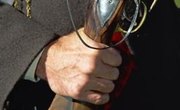Collecting pistols can be a rewarding hobby, but firing one brings history to life. Unfortunately, our ancestors could not simply purchase bullets. The process for loading a flintlock pistol was time-consuming and required a bit of expertise. You too can learn to load one with a little practice.
The Flintlock Pistol
Determine whether the gun is in good working condition and designed to fire. Many replicas capture the aesthetics of the real thing, but are not designed to shoot. Check the instruction manual if you are unsure. On the other hand, heirloom guns can suffer from lack of proper care. Consider the condition of your firearm before you attempt to fire it.
Loading
Gather primer, black powder, ball, patch, patch lube, flint and ramrod. The patch should be made of linen or cotton and lubricated with the patch lube. Load the flint into the cock. With the cock half-cocked, load the prescribed amount of black powder down the muzzle and tamp down. The amount varies with the gun, so you will have to do a little research. Wrap the ball in a patch and put in the muzzle. Tamp down the powder and ball with the ramrod. Prime the flash pan with a small amount of the primer, usually less than a third of a pan. The primer is a finely ground gunpowder.
What happens when the trigger is pulled is the flint hits the frizzen and creates sparks. The frizzen is designed to open the pan, so the sparks hit the primer. The primer ignites and a flash travels into the muzzle to ignite the black powder in the barrel. The powder fires, pushing the ball out of the barrel toward the target.
Caution
Do not use more than the prescribed amount of powder.
Always load gunpowder from a measure and not directly from flask or horn.
Remember you are working with gunpowder; avoid smoking when loading a flintlock.
Keep a dry cloth with you to wipe down the firing mechanism every few shots to prevent misfires and buildup.
Tip
Before loading your pistol, insert the ramrod into the empty muzzle. Mark the ramrod where it meets the end of the barrel. This gives you a gauge for later when you are tamping down the powder and ball.
References



